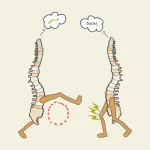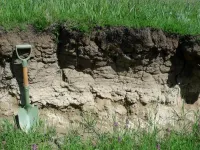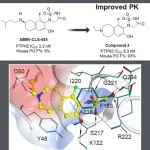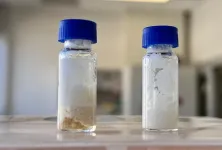(Press-News.org) Picture in your mind a traditional “landline” telephone with a coiled cord connecting the handset to the phone. The coiled telephone cord and the DNA double helix that stores the genetic material in every cell in the body have one thing in common; they both supercoil, or coil about themselves, and tangle in ways that can be difficult to undo. In the case of DNA, if this overwinding is not dealt with, essential processes such as copying DNA and cell division grind to a halt. Fortunately, cells have an ingenious solution to carefully regulate DNA supercoiling.
In this study published in the journal Science, researchers at Baylor College of Medicine, Université de Strasbourg, Université Paris Cité and collaborating institutions reveal how DNA gyrase resolves DNA entanglements. The findings not only provide novel insights into this fundamental biological mechanism but also have potential practical applications. Gyrases are biomedical targets for the treatment of bacterial infections and the similar human versions of the enzymes are targets for many anti-cancer drugs. Better understanding of how gyrases work at the molecular level can potentially improve clinical treatments.
Some DNA supercoiling is essential to make DNA accessible to allow the cell to read and make copies of the genetic information, but either too little or too much supercoiling is detrimental. For example, the act of copying and reading DNA overwinds it ahead of the enzymes that read and copy the genetic code, interrupting the process. It’s long been known that DNA gyrase plays a role in untangling the overwinding, but the details were not clear.
DNA minicircles and advanced imaging techniques reveal first step to untangle DNA
“We typically picture DNA as the straight double helix structure, but inside cells, DNA exists in supercoiled loops. Understanding the molecular interactions between the supercoils and the enzymes that participate in DNA functions has been technically challenging, so we typically use linear DNA molecules instead of coiled DNA to study the interactions,” said study author Dr. Lynn Zechiedrich, Kyle and Josephine Morrow Chair in Molecular Virology and Microbiology and professor of the Verna and Marrs McLean Department of Biochemistry and Molecular Pharmacology at Baylor College of Medicine. “One goal of our laboratory has been to study these interactions using a DNA structure that more closely mimics the actual supercoiled and looped DNA form present in living cells.”
After years of work, the Zechiedrich lab has created small loops of supercoiled DNA. In essence, they took the familiar straight linear DNA double helix and twisted it in either direction once, twice, three times or more and connected the ends together to form a loop. Their previous study looking at the 3-D structures of the resulting supercoiled minicircles revealed that these loops form a variety of shapes that they hypothesized enzymes such as gyrase would recognize.
In the current study, their hypothesis was proven correct. The team of researchers combined their expertise to study the interactions of DNA gyrase with DNA minicircles using recent technology advances in electron cryomicroscopy, an imaging technique that produces high-resolution 3-D views of large molecules, and other technologies.
“My lab has long been interested in understanding how molecular nanomachines operate in the cell. We have been studying DNA gyrases, very large enzymes that regulate DNA supercoiling,” said co-corresponding author Dr. Valérie Lamour, associate professor at the Institut de Génétique et de Biologie Moléculaire et Cellulaire, Université de Strasbourg. “Among other functions, supercoiling is the cell’s way of confining about 2 meters (6.6 feet) of linear DNA into the microscopic nucleus of the cell.”
As the DNA supercoils inside the nucleus, it twists and folds in different forms. Imagine twisting that telephone cord mentioned at the beginning, several times on itself. It will overwind and form a loop by crossing over DNA chains, tightening the structure.
“We found, just as we had hypothesized, that gyrase is attracted to the supercoiled minicircle and places itself in the inside of this supercoiled loop,” said co-author, Dr. Jonathan Fogg, senior staff scientist of molecular virology and microbiology, and biochemistry and molecular pharmacology in the Zechiedrich lab.
“This is the first step of the mechanism that prompts the enzyme for resolving DNA entanglements,” Lamour said.
“DNA gyrase, now surrounded by a tightly supercoiled loop, will cut one DNA helix in the loop, pass the other DNA helix through the cut in the other, and reseal the break, which relaxes the overwinding and eases the tangles, regulating DNA supercoiling to control DNA activity,” Zechiedrich said. “Imagine watching the rodeo. Like roping cattle with a lasso, supercoiled looped DNA captures gyrase in the first step. Gyrase then cuts one double-helix of the DNA lasso and passes the other helix through the break to get free.”
Co-corresponding author, Dr. Marc Nadal, professor at the École Normale in Paris confirmed the observation of the path of the DNA wrapped in the loop around gyrase using magnetic tweezers, a biophysical technique that allows to measure the deformation and fluctuations in the length of a single molecule of DNA. Observing a single molecule provides information that is often obscured when looking at thousands of molecules in traditional so-called “ensemble” experiments in a test tube.
Interestingly, the “DNA strand inversion model” for gyrase activity was proposed in 1979 by Drs. Patrick O. Brown and the late Nicholas R. Cozzarelli, also in a Science paper, well before researchers had access to supercoiled minicircles or the 3-D molecular structure of the enzyme. “It’s especially meaningful to me that 45 years later, we finally provide experimental evidence supporting their hypothesis because Nick was my postdoctoral mentor,” Zechiedrich said.
“This work opens a myriad of perspectives to study the mechanism of this conserved class of enzymes, which are of great clinical value,” Lamour said.
“This work supports new ideas on how DNA activities are regulated. We propose that DNA is not a passive biomolecule acted upon by enzymes, but an active one that uses supercoiling, looping and 3-D shapes to direct accessibility of enzymes such as gyrase to specific DNA sequences in a variety of situations, which will likely impact cellular responses to antibiotics or other treatments,” Fogg said.
Contributors to this work also include Marlène Vayssières (lead author), Nils Marechal, Long Yun, Brian Lopez Duran and Naveen Kumar Murugasamy. The authors are affiliated with one or more of the following institutions: Baylor College of Medicine, Université de Strasbourg, Institut de Génétique et de Biologie Moléculaire et Cellulaire, INSERM, Université Paris and Hôpitaux Universitaires de Strasbourg.
For a list of financial support for this work, see the publication.
###
END
Aya Takeoka at the RIKEN Center for Brain Science (CBS) in Japan and colleagues have discovered the neural circuitry in the spinal cord that allows brain-independent motor learning. Published in Science on April 11, the study found two critical groups of spinal cord neurons, one necessary for new adaptive learning, and another for recalling adaptations once they have been learned. The findings could help scientists develop ways to assist motor recovery after spinal cord injury.
Scientists have known for some time that motor output from the spinal cord can be adjusted through practice ...
Soil carbon usually refers only to the organic matter component of soils, known as soil organic carbon (SOC). However, soil carbon also has an inorganic component, known as soil inorganic carbon (SIC). Solid SIC, often calcium carbonate, tends to accumulate more in arid regions with infertile soils, which has led many to believe it is not important.
In a study published in Science, researchers led by Prof. HUANG Yuanyuan from the Institute of Geographic Sciences and Natural Resources Research of the Chinese Academy of Sciences (CAS) and Prof. ZHANG Ganlin from the Institute of Soil Science of CAS, together ...
Leuven (Belgium), 11 April 2024 — The role of the spinal cord is often simplified to that of a simple relay station, carrying messages between the brain and the body. However, the spinal cord can actually learn and remember movements on its own. A team of researchers at the Leuven-based Neuro-Electronics Research Flanders (NERF) details how two different neuronal populations enable the spinal cord to adapt and recall learned behavior in a way that is completely independent of the brain. These remarkable ...
In Star Trek: The Next Generation, Captain Picard and the crew of the U.S.S. Enterprise leverage the holodeck, an empty room capable of generating 3D environments, to prepare for missions and to entertain themselves, simulating everything from lush jungles to the London of Sherlock Holmes. Deeply immersive and fully interactive, holodeck-created environments are infinitely customizable, using nothing but language: the crew has only to ask the computer to generate an environment, and that space appears in the holodeck.
Today, virtual interactive environments are also used to train robots prior to real-world deployment in a ...
Salt marsh restoration can mitigate flood risk and bolster community resilience to climate change in our local waterways, according to a recent study published in Nature by a postdoctoral fellow with UC Santa Cruz’s Center for Coastal Climate Resilience (CCCR).
The study, titled “The value of marsh restoration for flood risk reduction in an urban estuary,” explores the social and economic advantages of marsh restoration amidst the growing threats of sea level rise and storm-driven flooding. Climate change will put many communities at risk. In California, some of the study co-authors from the U.S. Geological ...
In recent years, cancer immunotherapy, exemplified by PD-1 and its ligand PD-L1 blockade, has made remarkable advances. But while immunotherapy drugs offer new treatment possibilities, only about 20% to 40% of patients respond to these treatments. The majority either don't respond or develop drug resistance. Researchers are now looking for ways to enhance the scope of tumor immunotherapy in order to benefit a wider range of patients.
One such avenue is through the protein tyrosine phosphatase non-receptor type 2 (PTPN2) and its close superfamily member, PTPN1, identified in previous research as crucial modulators involved in the regulation ...
A new study in JAMA Network Open led by researchers from the CUNY Graduate School of Public Health and Health Policy observed 28,322 park users across 54 neighborhood parks and found a clear association between park renovation and park use in low-income neighborhoods in New York City (NYC).
As the global trend toward urbanization continues, two thirds of the world’s population is predicted to live in cities by 2050. Amid the noise, stress, and crowding of city life, urban parks have the potential to provide opportunities for physical activity, mitigate heat and pollution, lower stress, and improve mental and social well-being, all of which can decrease the prevalence ...
Adding one simple rule to an idealized game of billiards leads to a wealth of intriguing mathematical questions, as well as applications in the physics of living organisms. This week, researchers from the University of Amsterdam, including two master students as first authors – have published a paper in Physical Review Letters about the fascinating dynamics of billiards with memory.
Billiards: a mathematical mystery
An idealized version of the game of billiards has fascinated mathematicians for decades. The basic ...
While there’s no regulation in the U.S. for what’s in organic shampoos, they tend to contain ingredients perceived as safe or environmentally friendly. However, these “clean” shampoos separate and spoil faster than those made with synthetic stabilizers and preservatives. Now, researchers in ACS Sustainable Chemistry & Engineering demonstrate that a simple process — spinning organic shampoo at high speeds — improved the final products’ shelf lives and ability to clean hair.
Natural emulsifiers, such as xanthan gum and cetyl alcohol, ...
DURHAM, N.C. -- Left unchecked, corrosion can rust out cars and pipes, take down buildings and bridges, and eat away at our monuments.
Corrosion can also damage devices that could be key to a clean energy future. And now, Duke University researchers have captured extreme close-ups of that process in action.
“By studying how and why renewable energy devices break down over time, we might be able to extend their lifetime,” said chemistry professor and senior author Ivan Moreno-Hernandez.
In his lab at Duke sits a miniature version of one such device. Called an electrolyzer, ...





